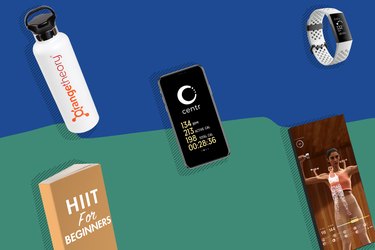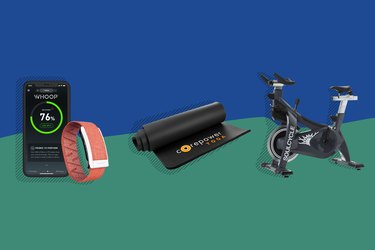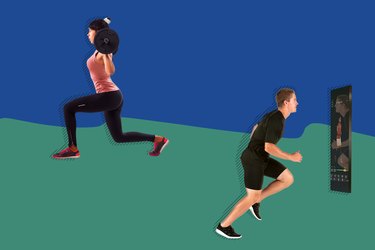
Fitness had a good year in 2019. We saw innovation in wearable tech, advancement in digital fitness and wider access to important recovery tools and mobility workouts. Wild fads (hi there, lemur yoga) will always pop in and out of our newsfeeds, but most of the ways exercisers spent their time getting sweaty this year indicate the future of fitness is bright.
Before we strap on our virtual reality headsets and dive into a new decade, let's take a look back at some of the fitness trends that defined 2019 and see which ones are worth bringing with us into 2020.
1. Kickboxing and Martial Arts Knocked Out the Competition
Defensive sports like boxing, kickboxing, Brazilian Jiu-Jitsu and Muay Thai went round by round with more traditional workouts in 2019.
When wellness industry technology platform Mindbody surveyed nearly 17,000 people at the end of 2018, kickboxing was the exercise that 18- to 45-year-olds said they were most interested in trying in the new year. Martial arts was sixth.
It seems people didn't just give it a try — they loved it! Boxing was the sixth most popular workout in 2019 on ClassPass, a fitness class booking platform, according to data shared with LIVESTRONG.com.
These sports offer a unique, high-intensity, full-body workout. In most boxing fitness classes, you can expect to jab, cross, hook and uppercut yourself sweaty while also working in sets of more traditional moves, such as mountain climbers or squats. In the process, you can torch as many as 400 to 500 calories an hour, improve your cardio stamina and sharpen your reaction time.
Women in particular are throwing more kicks and punches these days. Seventy percent of Rumble Boxing attendees are female, co-founder Noah Neiman tells LIVESTRONG.com, and that kind of majority seems pretty consistent across clubs: Women make up 60 percent of attendees at EverybodyFights and 75 percent at TITLE Boxing Club.
"I see a lot more women gravitating toward martial arts," says Ashley Borden, a celebrity fitness and lifestyle consultant and Brazilian Jiu-Jitsu blue belt. "Every year it's more and more."
While female celeb martial arts fans like Demi Lovato, Adriana Lima and Gal Gadot have definitely helped bring more interest — and women — to the ring, the trend is also likely thanks to boutique fitness studios purposefully creating environments that are more welcoming to a diverse membership base.
"We've been able to create a concept and community centered around inclusivity," Neiman says. "In Rumble Boxing, we were able to take a generally male-dominated athletic pursuit and make it more approachable to men and women alike. In doing so, we've seen a large percentage of women come try out the brand, disarmed by how we present boxing, and come to love it!"
But martial arts' increased popularity among women may also be part of a larger cultural shift: "The world is moving more toward female empowerment, and women taking their power back, and for me, Brazilian Jiu-Jitsu is probably one of the most self-empowering martial arts that I've ever done," Borden says. "Just the feeling of being able to protect yourself is incredible."
The Takeaway
Boxing and martial arts provide an outlet for pent-up frustration and stress, improve endurance and coordination and burn serious calories (among other mental and physical health benefits) — for both women and men. Inclusive studios have helped more people feel confident about giving the empowering workout a try.
2. 'Work Hard, Recover Hard' Replaced 'What Doesn't Kill You Makes You Stronger'
Recovery-focused classes and services first spiked in 2017 and have only grown more popular since. Sign-ups for tried-and-true methods like meditation and massage as well as more "out-there" options like full-body cryotherapy have continuously increased month-over-month throughout 2019, according to ClassPass.
The recent glorification of high-intensity cardio (like SoulCycle's transcendence from a single New York City studio in 2006 to nearly 100 locations in the U.S. and London in 2019) has finally (inevitably?) given way to a much-needed realization: You can't push your body to its breaking point and expect it to keep going without rest.
"In years past it would be, 'Go, go, go, harder, harder,' and now I'm seeing more supportive recovery workouts," says Holly Perkins, a certified strength and conditioning specialist and creator of The Comeback.
Entire classes are now devoted to stretching and mobility training — and they're expanding. Nationwide chain Stretch Lab, which was founded in 2015, now has more than 50 locations with an additional 19 coming soon.
Unsurprisingly, recovery tech is growing, too. Once only available to people who could afford the $600 price tags, massage guns — "percussive therapy" devices that deliver rapid massage-like pulses and are said to relieve muscle soreness and speed up post-workout recovery — finally dropped to more reasonable prices in 2019.
In April, industry leader Theragun debuted (slightly) more affordable versions of its massager on Amazon and at Walmart and announced a partnership with Life Time Fitness in October to bring its tools to the fitness chain's 144 locations.
Still, there isn't always rock-solid evidence for the recovery method du jour. For example, more research is needed before recommending cryotherapy widely.
But that definitely didn't stop achy exercisers from clamoring for cryotherapy this year. The human icicle treatment, which involves stepping into a freezing-cold chamber for a few minutes with the goal of relieving muscle pain, is expected to grow from a $206 million industry in 2019 to $319 million by 2024, according to a July 2019 report from research firm Markets and Markets.
The Takeaway
Giving your body time to rest and recover from tough workouts should be a non-negotiable, not just a trend. But it's important to follow the science and choose methods that are proven to be effective and safe.
Recovery techniques worth trying:
Save your money (aka techniques still up for scientific debate):
- Infrared anything, including saunas and pajamas
- Cryotherapy
- Floatation tanks

3. Digital Fitness Got Personal
Wearable technology has been No. 1 on the American College of Sports Medicine's (ACSM) annual list of fitness trends for two years in a row now (2019 and 2020), and has ranked in the list's top three every year since 2016.
Pair that with the never-ending flow of new fitness trackers (WHOOP and Apple Watch 5, anyone?) into the market as well as the astronomical $2.1 billion sale of Fitbit to Google in November and it becomes undeniably clear wearables are here to stay.
What was different in 2019, however, was the industry's movement into personal training territory. Trackers and apps now offer access to coaches and trainers on your wrist or in your pocket, and many are more affordable than gym memberships or personal training sessions.
For example, audio-guided workouts and coaching app Aaptiv costs $14.99 a month and WHOOP will run you $30 monthly — well below the $74 average monthly cost of just belonging to a gym, according to the International Health, Racquet and Sportsclub Association.
"Having a trainer in your phone is not only simple, but it allows the user to access their workouts whenever they want at a cheaper price than training in person," says Meg Takacs, Performix House trainer and creator of the #RunWithMeg app. "No matter where the client lives or the trainer works, the magic can happen."
While few of these options existed in years past, today, several are among the most popular health and fitness smartphone apps.
Users of Trainiac, an app that pairs users with certified personal trainers for one-on-one online coaching, grew by more than 600 percent over the last year, CEO and co-founder Akshay Ahooja tells LIVESTRONG.com, and was named a New App We Love by Apple in May.
Meanwhile, Aaptiv launched an AI-based coach to deliver personalized workout plans in June 2019 and consequently saw a 25 percent increase in the average number of weekly workouts completed by users, according to data provided to LIVESTRONG.com.
The Takeaway
If you've ever wanted a personal trainer or a more customized fitness plan but didn't have the wiggle room in your budget, these apps and trackers are a great entry point. Just be careful to avoid two common pitfalls of fitness trackers: device burnout (relying on it so much you eventually get sick of it) and overuse (becoming so obsessed with the data that you no longer focus on the actual workouts).
4. At-Home Workouts Went High-Tech
Technology-enhanced at-home workouts and equipment took the idea of the fitness app even further, offering an exercise solution to those of us who prefer to sweat in the comfort of home yet still crave human interaction and live feedback.
The Mirror, an interactive full-length-mirror-turned-home-gym, launched with streaming and on-demand video workouts in the fall of 2018. But by fall 2019, the deal got even sweeter: Through the device's camera and speakers, users can now benefit from one-on-one personal training sessions for just $40 a pop.
Peloton's expanded offerings also dominated: The brand's connected membership service (the bike is a separate cost) nearly doubled between 2018 and 2019, and it posted revenue just shy of $1 billion in fiscal year 2019, according to documents filed before it went public this fall.
At the time, it also touted a 95 percent retention rate for 12-month memberships, meaning fans are committed to this system. And in December, the brand announced a partnership with Amazon's Fire TV streaming devices and smart TVs to bring Peloton to television for the first time.
These big-ticket items aren't for everyone's budget: The Peloton bike starts at $2,245 and the Mirror at $1,495. But if you can afford them, they'll help you ride the wave of this trend, which isn't going anywhere. The market for at-home fitness equipment is expected to roughly double from 2018 to 2025, according to a November 2018 report from research marketing firm Allied Market Research.
"For new parents, folks who work long hours, people who don't thrive in a gym environment and people who don't have access to a boutique cycling studio or whose local spot doesn't have a convenient schedule, owning your own bike is a really practical way to cycle consistently and comfortably," says Alex Lyons, stadium cycling and precision training instructor with Flywheel Sports.
The Takeaway
The biggest drawback here is the price tag. Even a smaller splurge like the connected boxing system FightCamp will still run you about $500, which is less than an average yearly gym membership (about $700), but still not nothing. Ultimately, you don't need to drop crazy amounts of cash to get an effective at-home workout: A couple sets of dumbbells or kettlebells in a few different weights won't put as big of a dent in your budget, and you can appreciate your reasonable investment knowing that free-weights exercises are the ACSM's fourth biggest trend for 2020.
At-home workouts we love:

5. HIIT Got Smaller — In a Big Way
"We're a society of fast-paced movement," says Hillary Cauthen, PsyD, co-owner of Texas Optimal Performance & Psychological Services, LLC, and executive board member of the Association for Applied Sport Psychology. And in this busy world, even our workouts need to be streamlined.
Cauthen calls HIIT, which involves alternating short bursts of high-intensity activity with brief rest periods, a "drive-through workout" because it's a quick way to squeeze an effective sweat session into a packed schedule.
"People love the idea of efficiency, that they could get farther, faster, that they could get fitter, faster," Perkins adds.
HIIT has reigned for years: It's been in the top five on ACSM's annual list of fitness trends since 2014; it placed third in 2019 and is back up to second for 2020.
But this was the year that HIIT got even more efficient. Once the U.S. Department of Health and Human Services updated its exercise recommendations in late 2018 to emphasize simply moving more — nullifying the longstanding 10-minute minimum for physical activity to "count" as exercise — micro-HIIT, well, hit: 2- to 6-minute "exercise snacks" flourished (and are here to stay), according to Equinox.
The term "exercise snacking" was coined several years ago but shot to viral fame in January 2019 after a (very small) study published in Applied Physiology, Nutrition and Metabolism found that charging up three flights of stairs three times a day for three days a week actually resulted in improved cardio fitness.
The HIIT way of thinking is not just for cardio and strength training anymore. "There are so many new, creative ways to apply the concept," Perkins says. Today, you can find HIIT fusion studios upping the intensity on traditionally more laid-back modalities, such as yoga and Pilates, snack-sized or otherwise.
And (added bonus) shelling out for HIIT classes isn't even necessary. "You don't need a gym membership, and it can be done literally anywhere, which is appealing to all, from newbies to seasoned athletes," certified personal trainer SJ McShane tells LIVESTRONG.com.
We're calling it: HIIT is the trend of the decade.
The Takeaway
If you're struggling to fit in your weekly workouts and have a solid fitness base, HIIT might be just what you need. But it's also not for everyone, especially if you're injured, recovering from an injury or have a heart condition. Get the OK from your doctor or physical therapist before diving in.
What's Next?
There will always be fitness trends that promise too-good-to-be-true strength gains or results on the scale. It takes careful attention (and sometimes expert help) to decipher what's really worth your gym time. Whether you help yourself to an exercise snack, upgrade your fitness tracker or strap on some boxing gloves for the first time, you can't go wrong with the top trends of 2019. As for next year, we predict those virtual reality headsets really are in your future.